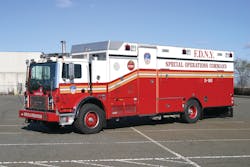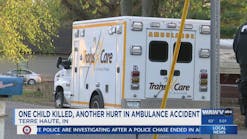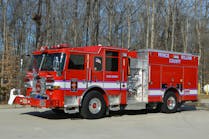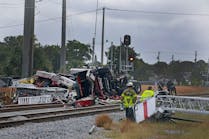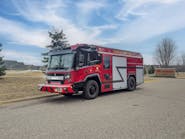The terrorist attacks of Sept. 11, 2001, destroyed a large portion of the FDNY’s special operations capabilities. More than 90 of the firefighters and officers killed that day were trained technicians assigned to rescue squad and hazardous materials units. Many more would subsequently retire as a result of that day. Many special apparatus were also destroyed when the towers collapsed.
In the weeks and months that followed, the department identified potential areas of concern in the event of future terrorist attacks, considering the likely potential of multiple, simultaneous incidents. This planning was coupled with an all-hazards approach to deal with natural disasters as well as terrorist incidents. Among the factors considered was the ability to handle multiple, simultaneous large-scale incidents by having each borough capable of sustaining operations independently, as much as possible, without relying on the response of special units from other boroughs. In an effort to rebuild the department with greater special-operations capabilities, extensive training, procurement of tools and equipment, and the acquisition of many new apparatus were required.
To accomplish this, units were selected and trained in specific specialty areas and many new special apparatus were acquired. To ensure the optimal availability and distribution of resources, a tiered response system of layered response grades of incrementally higher levels of specialized capabilities was established. This allows for deployment of an appropriate mix of special units, while simultaneously maintaining adequate capabilities to manage additional incidents citywide. Existing engine and ladder companies, as well as EMS units, took on additional functions and designations, and specialized vehicles were acquired, providing capabilities that did not exist prior to the attacks.
Many of these units are pre-designated to operate as part of specific task forces such as Technical Decon Task Forces, Collapse Task Forces and Rescue Medical Task Forces, to expedite the assignment of specific resources to an incident.
While the terrorist attacks of 2001 took a tremendous toll, decimating the department, these new initiatives and others have helped to currently position the department to deal with future threats and incidents.
In addition to the apparatus pictured, the department has placed the following units into service:
- Fire Department Operations Center (FDOC) – Known as the “War Room,” the FDOC is staffed by both fire and EMS personnel. It tracks citywide resources, monitors multiple radio networks, and can access maps, building diagrams, photos, building data, floor plans, satellite images, multiple databases of other agencies, live feeds from news media helicopters and other sources to provide information to on-scene incident commanders.
- Air Recon Chief – Selected battalions have been trained and equipped to function as airborne observers. They are deployed as required via New York Police Department helicopters.
- Planning Chief – Selected battalions have been trained to operate as planning chiefs at large-scale incidents. Their function is to gather required information, coordinate with the incident commander and plan for deployment of resources for the operational period.
- Transit Liaison Officer – Selected battalions have been trained to operate as liaison officers between transit officials and incident commanders. They respond to the respective transit operations center during a transit incident.
- Center for Terrorism and Disaster Preparedness – Personnel analyze terrorist attacks worldwide, develop tactics and training programs, perform threat analysis of potential targets, conduct full-scale exercises, interact with federal and local agencies, and produce informational bulletins for field units.
- Reserve SOC Units – A fully equipped reserve rescue apparatus is quartered at Ladder 20 in Manhattan. A fully equipped reserve squad apparatus is stored at Engine 270 in Queens. A fully equipped reserve hazardous materials apparatus is stored at Engine 206 in Brooklyn. These units can be activated immediately with recall personnel. They are sometimes used for special events where a specific threat hazard has been identified.
- Decon Shower Units – Prior to 9/11, there was one tractor-drawn decontamination unit. In 2003, two tractor-drawn decontamination units, built by Advanced Containment Systems and pulled by 2002 Freightliner tractors, were assigned to Engines 37 in Manhattan and 283 in Brooklyn. They have the ability to process more than 250 people per hour. Three smaller decontamination units were delivered by Ferrara in 2006, built on Mack chassis. These units are assigned to Engine 4 in Manhattan, Engine 160 on Staten Island and Engine 251 in Queens.
- Planning Vehicle – This vehicle is used by the Incident Management Team (IMT) and/or Planning Chief at major operations. The vehicle is a 2006 Freightliner/Utilimaster outfitted by LDV. It contains a briefing area, data processing area, kitchen, toilet, GIS/reproduction area, two-position operating area, generator, phones, radios, TV and image-projection capability.
- Auxiliary Water System – The Auxiliary Water System was designed to replace water mains damaged in an attack, as happened at the World Trade Center. Components of the system can also be used at major dewatering operations. The system consists of three skid-mounted large-capacity mobile pumping stations. These are fed by smaller, submersible pumps. A 2011 KenworthT370 roll-off unit can transport the pumps, which are kept at Engine 159 on Staten Island, Ladder 20 in Manhattan and Rescue 3 in the Bronx. The satellite units and airport hose wagons are transitioning to six-inch hose to use with this system.
- Hazmat Battalion – Members are trained to the hazmat technician level and the unit responds to significant hazardous materials incidents, whenever Hazmat 1 or a Hazmat Technician unit responds.
